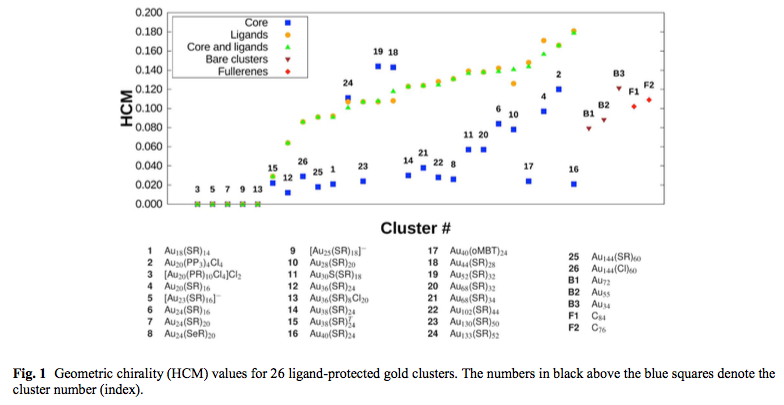J. Jesús Pelayo 1, Robert L. Whetten 2, Ignacio L. Garzón 1
1. Instituto de Física, Universidad Nacional Autónoma de México, México, D. F., Mexico
2. Department of Physics and Astronomy, University of Texas, San Antonio, 78249 San Antonio, Texas, USA
Chirality has been found as a relevant property of nanomaterials, including ligand-protected metal clusters and nanorods [1-4]. This property is not only crucial in nanotechnology developments related with asymmetric catalysis and chiroptical phenomena, but also generates fundamental questions on the existence of chirality at the nanoscale. In fact, x-ray total structure determination, electron diffraction studies, NMR and circular dichroism spectroscopies, as well as theoretical calculations performed on gold clusters protected with thiolate or phosphine ligands have confirmed the existence of chiral structures in the size range of 18-144 Au atoms. In this work [5], we realize a comparative analysis of the degree or amount of chirality existing in chiral ligand- protected gold clusters (LPGC), through a geometric quantification, using the Hausdorff chirality measure (HCM) [6]. The calculated HCM values provide a quantitative framework to compare, classify, and gain insight into the origin of chirality. Interestingly, these values are consistent with the current knowledge on the different sources of chirality: achiral cores and chiral arrangement of ligands in, for example, Au102(SR)44 and Au38 (SR)24, or intrinsically chiral cores, like in Au52(SR)32 and Au20 protected with phosphine ligands. Our calculations are also helpful to assign an index of chirality, and classify as chiral several recently synthesized and structurally solved LPGC that, in first instance, were not identified as such. The calculated HCM values are used to extract trends on how chirality is spatially distributed in LPGC, and correlate them with optical activity measurements. The main trend indicates that the Au-S interface has the dominant role in the chirality of LPGC [5].

References
[1]H. Yao, Optical Active Gold Nanoclusters, Curr. Nanosci. 4, 92 (2008).
[2] C. Noguez, I. L. Garzón, Optically Active Metal Nanoparticles, Chem. Soc. Rev. 38, 757 (2009).
[3] C.Gautier,T.Bürgi,ChiralGoldNanoparticles,Chem.Phys.Chem.10,483(2009).
[4] S.Knoppe,T.Bürgi,ChiralityinThiolate-ProtectedGoldClusters,Acc.Chem.Res.47,1318(2014).
[5] J.J.Pelayo,R.L.Whetten,I.L.Garzón,GeometricQuantificationofChiralityinLigand-ProtectedMetalClusters,J.Phys.Chem.
C 119, 28666 (2015).
[6] A.B.Buda,K.Mislow,AHausdorffChiralityMeasure,J.Am.Chem.Soc.114,6006(1992).
